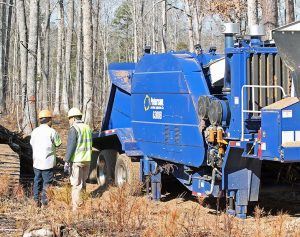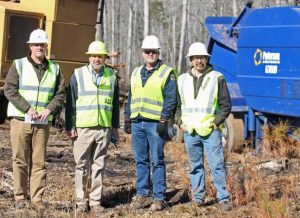Chipping for Answers
Energy Efficiency in Wood Chips Made for Energy Production
Chris Hopkins, a research associate with North Carolina State University, is pretty good at finding partners when he sets his sights on a new project. His latest research revolves around energy efficiency in wood chips made for energy production.
Hopkins’ own tests demonstrated that dryer chips produce a higher energy value. So, he thought, how can we ship the driest chips from the woods to the end point facility? Could you stack the trees and residue targeted for the chipper on site and effectively dry them out? And what would be the best way to do that? These were all questions Hopkins sought to discover.

First, he needed a willing landowner. Enter David Schnake, who works for the North Carolina Department of Agriculture. One of the properties Schnake manages is the Picture Creek section of the Umstead Research Station located in Granville County. Schnake was looking to reduce the basal area within the stand by removing the existing Loblolly Pines on the mixed hardwood/pine stand.
Hopkins utilized about 60 acres of the 230 acre tract. Schnake states the tract is registered with the Natural Heritage Program due to the significant array of unique plants, including the Smooth Cone Flower.
So, for Schanke, the research project would provide an excellent chance for him to utilize fiber that ultimately would have just been harvested and left on the forest floor as he worked towards restoring the property to its former landscape of years ago of Oak mixed in with Shortleaf Pine and savannah grasses.
Schnake pointed out that the goals of the Department of Agriculture involve different projects – research, production and in some cases, restoration. This project falls in the restoration bucket. He hopes to achieve the landscape through harvests and a burn schedule.
In June of 2014, trees that were to be left were marked and the harvesting began.
Hopkins had specific plans for the wood earmarked for energy and where they would be left on the tract. In some spots, he had the logger leave a clump typically left by one skidder grab. In other spots, he developed windrows, which look like man-made hedges of small diameter trees along the sides of the tract. His was trying to discover how quickly the trees reduce moisture and does placement and structure make a difference.
“We measured all the dynamics we could while they were drying,” stated Hopkins. He would test them shortly after harvest and then revisit the tested spots for follow-ups. Hopkins also took the time to cut three-foot spaces between the windrows to increase air movement. “Everything we tried early on really didn’t work,” stated Hopkins. “We expected better results from the windrows.”
In the end, Hopkins learned a few things. First and foremost, the small piles left by the skidder actually were the optimal drying of the woody material and small diameter trees. Hopkins surmises that the air flow was greater than that of the windrows. He also discovered that the trees lose moisture from the butt of the tree rather than length of the tree exposed to the wind. “The bark is a blanket,” stated Hopkins. “The bottom line is that we learned that you can dry wood out with a lot less effort than we expected.”
Crowder Logging did the initial harvest of the property, but after letting the wood targeted for the energy market sit for two years, Hopkins needed a partner on the production side. Enter Joey Ross of J & J Logging. J & J Logging had assisted Hopkins about six years ago with another research project so it seems once you end up in this researcher’s rolodex, you are there for life.
“He is persistent,” stated Joey Ross with a smile. “He will call, and keep calling, and if he doesn’t catch up with me, he’ll get my dad. And then, my dad will say, hey, sort this out. So yes, we help him out when we can.”
But on a more serious note, Joey Ross likes to help out where he can because he believes breakthroughs in research could pay dividends in new markets or higher returns on existing markets for his company and the logging world in general. He likens it to medical research where new medicines take years to develop. “If I didn’t believe that something good would come out of this, I would have quite fooling with it a long time ago,” stated Ross. “As long as it doesn’t cut into our production too much, we do whatever he needs.” “We really appreciate his willingness to work with us,” stated Hopkins. “It’s invaluable to our projects.”
The final element of the partnership for this study was the chipper equipment. Enter Gregory Poole Forest Products and Peterson Corporation. Hopkins reached out to Peterson inquiring about some help with his demonstration.

Hopkins’ sales pitch must have been good. The Peterson and Gregory Poole people delivered Peterson’s newest machine, a 6300B Drum Chipper, which can produce a bunch of wood chips in a range of sizes; from 1/8 inch (typically requested by pellet markets) to 2 inches (typically requested by fuel markets) depending upon the setup.
“It’s our newest machine,” stated Steve Jones with Peterson. “It is designed for high volume that you would find with large land clearing operations and/or right of way clearings.”
While everyone in the forest products supply chain was willing to get onboard to make this research a reality, Hopkins struggled to find the end consumer who would be willing to install the proper equipment to test the wood chips for moisture as they came into the facility. There are a few options for sensors in existence, but the time and capital associated with the project proved to be too big of an obstacle to overcome.
“The entire project really hinges on being able to place a premium on dryer wood chips at the mill, but since the sensor equipment is an apparent road block, it looks like it will not happen in the near future,” stated Hopkins.
From his research, Hopkins concludes that wood loses over 10 percent of its moisture in just one week in a small pile. If left on the jobsite for eight months in a windrow, it loses slightly more, closer to 20 percent.
Hopkins sees the efficiencies in terms of logistics that could be created in the future by a larger amount of lighter, more efficient energy wood chips being transported to a facility with the expectation of a premium for those wood chips, but that is not how the marketplace is set up currently.
— Chris Brown, North Carolina Forestry Association

